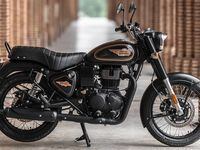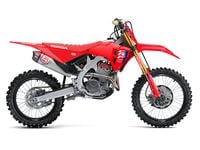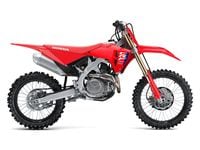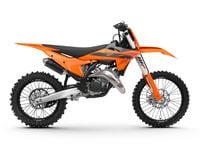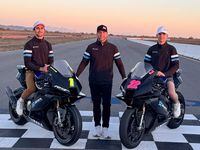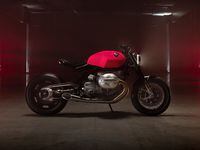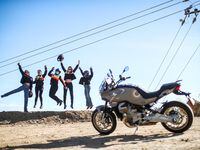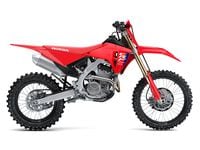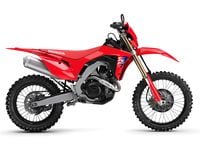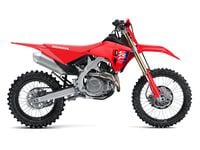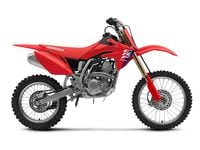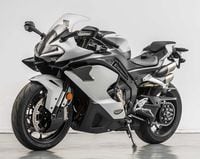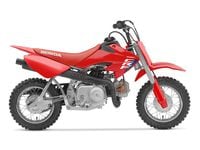Ultimate test of man and machine? Hard to argue against the Pikes Peak International Hill Climb. It’s a merciless 156 corners with long, fast straights clinging to the edge of a mountain and puts every move under a magnifying glass. KTM’s design philosophy behind the 2019 790 Duke suggests it was tailored for this race. It should come as no surprise, then, that this is where the 790 made its race debut in 2018 in the trusted hands of retired MotoAmerica factory superbike racer and KTM testing ace Chris Fillmore.
The Orange Brigade set its sights on building a middleweight naked with worthy power and pinpoint handling—a mountain destroyer, if you will. After a day ripping up Southern California's own Palomar Mountain aboard the 790 Duke, I'd argue KTM succeeded.
As is usually the case with performance-driven KTM, the overall design focus was on making the 790 Duke compact and lightweight. This started with the all-new 799cc parallel twin. It gets a lightweight, one-piece forged crankshaft with a 75-degree crankpin offset for an uneven 435-degree firing order, giving the 790 a V-twin sound and personality familiar with the Duke family. Forged pistons and connecting rods help with vibration and weight reduction, as do the DLC-coated finger followers, smaller cam lobes, and a secondary balancer shaft operated by the exhaust cam. Output is 95.1 hp at 9,200 rpm and 58.2 pound-feet of torque at 7,900 rpm on the Cycle World dyno; by comparison, the Yamaha MT-09 produced 105.4 hp at 9,980 and 60.5 pound-feet of torque at 8,460 rpm. What the dyno numbers don't convey is how free-revving the 790 is.
Opening the 790 Duke’s ride-by-wire throttle suggests real-world performance is not dramatically different between the two though, with the parallel twin offering readily available power from 3,500 rpm. Initial power delivery is smooth at low revs, even if the transition between on/off throttle is sometimes overly sensitive in the Sport riding mode at low speeds—a quick switch to Street mode solves the issue. Power comes on strong in the midrange—lofting the front wheel as the bike accelerates away from corners—and only tapers off near its 9,500 rpm redline. KTM’s Quickshifter+ adds to the excitement, allowing wide-open throttle upshifts through the Duke’s well-spaced-ratio, six-speed gearbox. What does the “+” mean? It also auto-blips for no-clutch downshifts.
KTM carried over its lean-angle-sensitive Motorcycle Traction Control (MTC) and Cornering ABS rider aids to the 790 Duke from the larger 1290 LC8 models, which work in conjunction with a five-axis Bosch IMU for dead-on precision. Traction-control settings are preset in three of the selectable riding modes, while Race mode offer nine levels of adjustability. Additionally, a feature called Motor Slip Regulation (MSR) works something like a corner-entry traction control system that prevents rear-wheel slip on deceleration by opening the throttle butterflies as needed. Seriously trick stuff, especially for a middleweight naked.
What does this mean for the Duke? Think of the electronics suite as the ultimate riding coach, enhancing your riding instantaneously. No time wasted. The traction control system does a good job of only intervening as necessary to mitigate wheelspin in middle-ground settings, but isn’t aggressive enough to kill corner-exit acceleration. While the highest TC settings hinder the 790’s ability to accelerate, the strong intervention suggests the Duke would have no issue conquering rain-soaked tarmac. The MSR goes a long way in keeping the KTM in check too. Downshifting in quick succession comes with no extra thought, the system seamlessly working to keep wheels in line. Go ahead, drive deep into that corner. It dares you.
The Duke’s chassis provides a sure-footed feel throughout the corner. KTM’s work at damping engine vibration means it could use the powerplant as a stressed member of the frame, helping reduce weight and boost agility. At 414 pounds fully fueled, the 790 carves difficult side-to-side transitions with ease. The twistier the road, the more the Duke thrives. KTM’s choice of Maxxis Supermaxx ST tires helps here, providing gobs of grip and feel from corner entry to exit.
Suspension components are the obvious kryptonite for the 790, but only because of their lack of adjustability, save for the stepped rear spring-preload adjuster. That’s not to say the 43mm WP fork and shock don’t offer well-chosen spring rates that deliver a good balance of support or that there isn’t pretty solid overall feel, but front and rear are racetrack stiff and non-compliant on rough roads. The Duke has a tendency to jostle underneath you, and ride comfort suffers when the asphalt is less than ideal. Frankly, the Duke’s lack of suspension adjustability is disappointing, which is only emphasized more when considering the 790 comes equipped with a host of other top-shelf features, like its full electronic rider-aids suite.
Feel from the KTM-branded brake calipers is also lackluster. Initial pull on the lever offers a strong bite, but nearing the apex a lack of feel makes it difficult to understand how much braking force is being applied. It’s a good thing then that the Duke comes equipped with Cornering ABS, which intervenes almost unnoticeably as you trail-brake, a compliment to the rider-aid system’s precision.
Comfortable ergonomics make up for faults in the 790’s suspension setup, even if an overly stiff saddle irritates the glutes after more than a half hour of riding. We found the narrow chassis makes the 32.5-inch seat height feel lower than it is, so the Duke is easy to handle in stop-and-go traffic or parking-lot situations. Still, there’s plenty of legroom to the pegs; the Duke should have no problem fitting riders taller than my 5-foot-7-inch frame. A long reach to the relatively low handlebars gives the 790 Duke an aggressive feel, but it’s not so extreme that it applies an awkward pressure to your wrists. Our bodies thank you, KTM.
The long-awaited KTM 790 Duke is a seriously potent motorcycle. The Orange Brigade suggests the middleweight Duke is a steppingstone between the 390 Duke and 1290 Super Duke R, but I’d argue it holds the potential to be a final destination for a KTM buyer. It has everything a serious enthusiast could ask for, hold for more suspension adjustability, and represents a good value in the class at $10,499.
Oh, and if Pikes Peak is the ultimate test, then the 790 passed with flying colors—in its first outing it climbed the mountain in just 10 minutes flat, earning KTM top honors and a course record in the middleweight class. As for us riding on our real-world mountain, the 790 Duke was a willing, fun companion. Even if your personal ultimate test is mostly just a daily commute.
/cloudfront-us-east-1.images.arcpublishing.com/octane/HERTSQMNJRH4NENU4EADMEICZY.jpg)
/cloudfront-us-east-1.images.arcpublishing.com/octane/ERAVPBGNI5AK5H6TJUFKDBV5UQ.jpg)
/cloudfront-us-east-1.images.arcpublishing.com/octane/UDBFN5DNYBAMFECSFF25GG3TSE.jpg)
/cloudfront-us-east-1.images.arcpublishing.com/octane/2QQOQMEXERFG5LOYQFMQAMONKU.jpg)
/cloudfront-us-east-1.images.arcpublishing.com/octane/BPTILEW7OFFMBDCYNWTJZGJVXI.jpg)
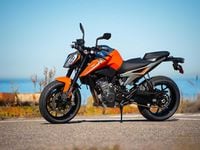
/cloudfront-us-east-1.images.arcpublishing.com/octane/ZFA75HIKPNFTDOQP5RA4KVWZP4.jpg)
/cloudfront-us-east-1.images.arcpublishing.com/octane/5IDO656U6VBZ7IFJIHWAM4ALQM.jpg)
/cloudfront-us-east-1.images.arcpublishing.com/octane/DY7GZ4637VH3TCKLE33YJTBHCA.jpg)
/cloudfront-us-east-1.images.arcpublishing.com/octane/MKJLGJ7ZWJABFGPU73OJIICE6Q.jpg)
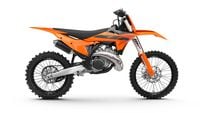
/cloudfront-us-east-1.images.arcpublishing.com/octane/N575KB7BDZDPPJBRLZRG2ANHKI.jpg)
/cloudfront-us-east-1.images.arcpublishing.com/octane/T77HXRXV4NGKDNZODMSEIBRXPE.jpg)
/cloudfront-us-east-1.images.arcpublishing.com/octane/NKMM7V2P3BCSXAV6J56FKK67OU.jpg)
/cloudfront-us-east-1.images.arcpublishing.com/octane/SWQRQV27DNFA7LXGFI7FNFNGOQ.jpg)
/cloudfront-us-east-1.images.arcpublishing.com/octane/GYEXUJBV5JGQLLZNXO7KRVSTEY.jpg)
/cloudfront-us-east-1.images.arcpublishing.com/octane/MCWUSJJVJVG45P7QQG3WOXZR54.jpg)
/cloudfront-us-east-1.images.arcpublishing.com/octane/AJ4EFPH2CRDURDAB5LPEA2V2NE.jpg)
/cloudfront-us-east-1.images.arcpublishing.com/octane/LSDHIL22SZAFFPYLKP5ZXLJSIY.jpg)
/cloudfront-us-east-1.images.arcpublishing.com/octane/SH46HIOX4RELXLXF6AE3SFGH4A.jpg)
/cloudfront-us-east-1.images.arcpublishing.com/octane/JUZ52WFWLJGMNH7PGZNOKP3MUY.jpg)
